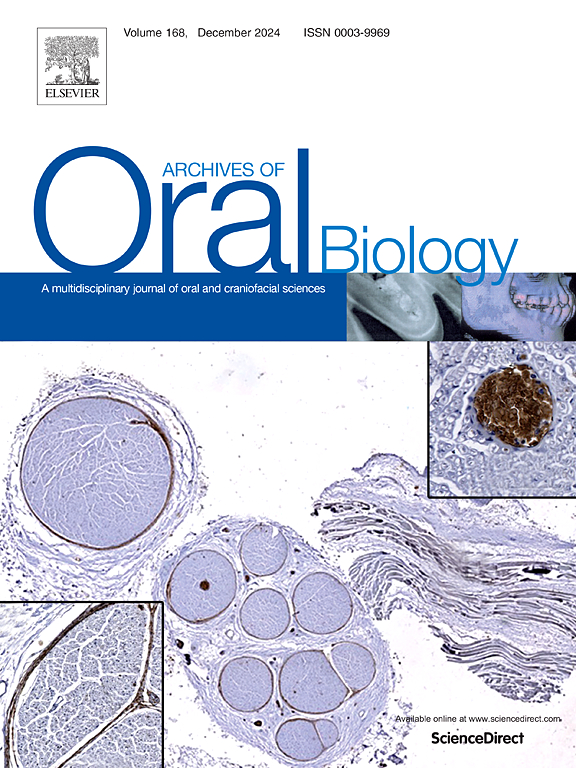ZBP1-NLRP3 axis integrates PANoptosis and ferroptosis during inflammatory injury in human dental pulp fibroblasts
IF 2.1
4区 医学
Q2 DENTISTRY, ORAL SURGERY & MEDICINE
引用次数: 0
Abstract
Objective
To define how Z-DNA binding protein 1 (ZBP1) and NOD-like receptor family pyrin domain-containing 3 (NLRP3) signaling regulate lipopolysaccharide (LPS)-induced inflammation, PANoptosis, and ferroptosis in human dental pulp fibroblasts (HDPFs).
Design
HDPFs were treated with LPS, and ZBP1 and NLRP3 were silenced using small interfering RNA (siRNA), individually or in combination. Inflammatory mediators and death-pathway markers were quantified by quantitative real-time PCR (qRT-PCR), Western blotting, enzyme-linked immunosorbent assay (ELISA), and biochemical assays; Annexin V/propidium iodide flow cytometry assessed cell-death distributions.
Results:
LPS significantly increased ZBP1 and NLRP3 expression and elevated cytokine/chemokine release; each was attenuated by ZBP1 or NLRP3 knockdown, with the greatest reduction after dual silencing. LPS triggered PANoptosis, as indicated by increased Annexin V⁺/PI⁺ cell populations and upregulation of caspase-1, cleaved caspase-8, RIPK3, GSDMD, and p-MLKL/MLKL, which were significantly reduced by inhibition of the ZBP1-NLRP3 axis. Ferroptosis features were also evident after LPS, including impaired iron homeostasis (downregulated ferritin heavy chain 1 [FTH1] and ferroportin [FPN1] with Fe²⁺ accumulation), enhanced lipid peroxidation (upregulated ALOX15, LPCAT3, PTGS2 with increased malondialdehyde and lipid reactive oxygen species), and weakened antioxidant defenses (reduced glutathione peroxidase-4 [GPX4], solute carrier family 7 member 11 [SLC7A11], glutathione, and GPX4 activity). These changes were mitigated by single-gene silencing and most effectively by dual knockdown.
Conclusion
The ZBP1-NLRP3 axis acts upstream to coordinate LPS-induced PANoptosis and ferroptosis in HDPFs. Targeting this axis dampens inflammatory cell death and oxidative-metabolic dysregulation, highlighting a potential therapeutic strategy for pulpitis-related tissue injury.
ZBP1-NLRP3轴整合了人牙髓成纤维细胞炎症损伤过程中的PANoptosis和ferroptosis。
目的:探讨Z-DNA结合蛋白1 (ZBP1)和nod样受体家族pyrin结构域3 (NLRP3)信号通路如何调控脂多糖(LPS)诱导的人牙髓成纤维细胞(HDPFs)炎症、PANoptosis和ferroptosis。设计:用LPS处理hdpf,用小干扰RNA (siRNA)单独或联合沉默ZBP1和NLRP3。采用实时荧光定量PCR (qRT-PCR)、免疫印迹法(Western blotting)、酶联免疫吸附法(ELISA)和生化法对炎症介质和死亡途径标志物进行定量分析;膜联蛋白V/碘化丙啶流式细胞术评估细胞死亡分布。结果:LPS显著增加ZBP1和NLRP3的表达,增加细胞因子/趋化因子的释放;通过敲除ZBP1或NLRP3,它们都被减弱,双重沉默后的减弱幅度最大。LPS触发PANoptosis, Annexin V + /PI +细胞数量增加,caspase-1、cleaved caspase-8、RIPK3、GSDMD和p-MLKL/MLKL表达上调,这些表达通过抑制ZBP1-NLRP3轴而显著降低。脂多糖后的铁中毒特征也很明显,包括铁体内平衡受损(铁蛋白重链1 [FTH1]和铁转运蛋白[FPN1]以Fe 2 +积累下调),脂质过氧化作用增强(ALOX15、LPCAT3、PTGS2上调,丙二醛和脂质活性氧增加),抗氧化防御能力减弱(谷胱甘肽过氧化物酶-4 [GPX4]、溶质载体家族7成员11 [SLC7A11]、谷胱甘肽和GPX4活性降低)。这些变化可以通过单基因沉默和双基因敲除来缓解。结论:ZBP1-NLRP3轴在lps诱导的HDPFs PANoptosis和ferroptosis中起上游协调作用。靶向该轴抑制炎症细胞死亡和氧化代谢失调,强调了牙髓炎相关组织损伤的潜在治疗策略。
本文章由计算机程序翻译,如有差异,请以英文原文为准。
求助全文
约1分钟内获得全文
求助全文
来源期刊

Archives of oral biology
医学-牙科与口腔外科
CiteScore
5.10
自引率
3.30%
发文量
177
审稿时长
26 days
期刊介绍:
Archives of Oral Biology is an international journal which aims to publish papers of the highest scientific quality in the oral and craniofacial sciences. The journal is particularly interested in research which advances knowledge in the mechanisms of craniofacial development and disease, including:
Cell and molecular biology
Molecular genetics
Immunology
Pathogenesis
Cellular microbiology
Embryology
Syndromology
Forensic dentistry
 求助内容:
求助内容: 应助结果提醒方式:
应助结果提醒方式:


